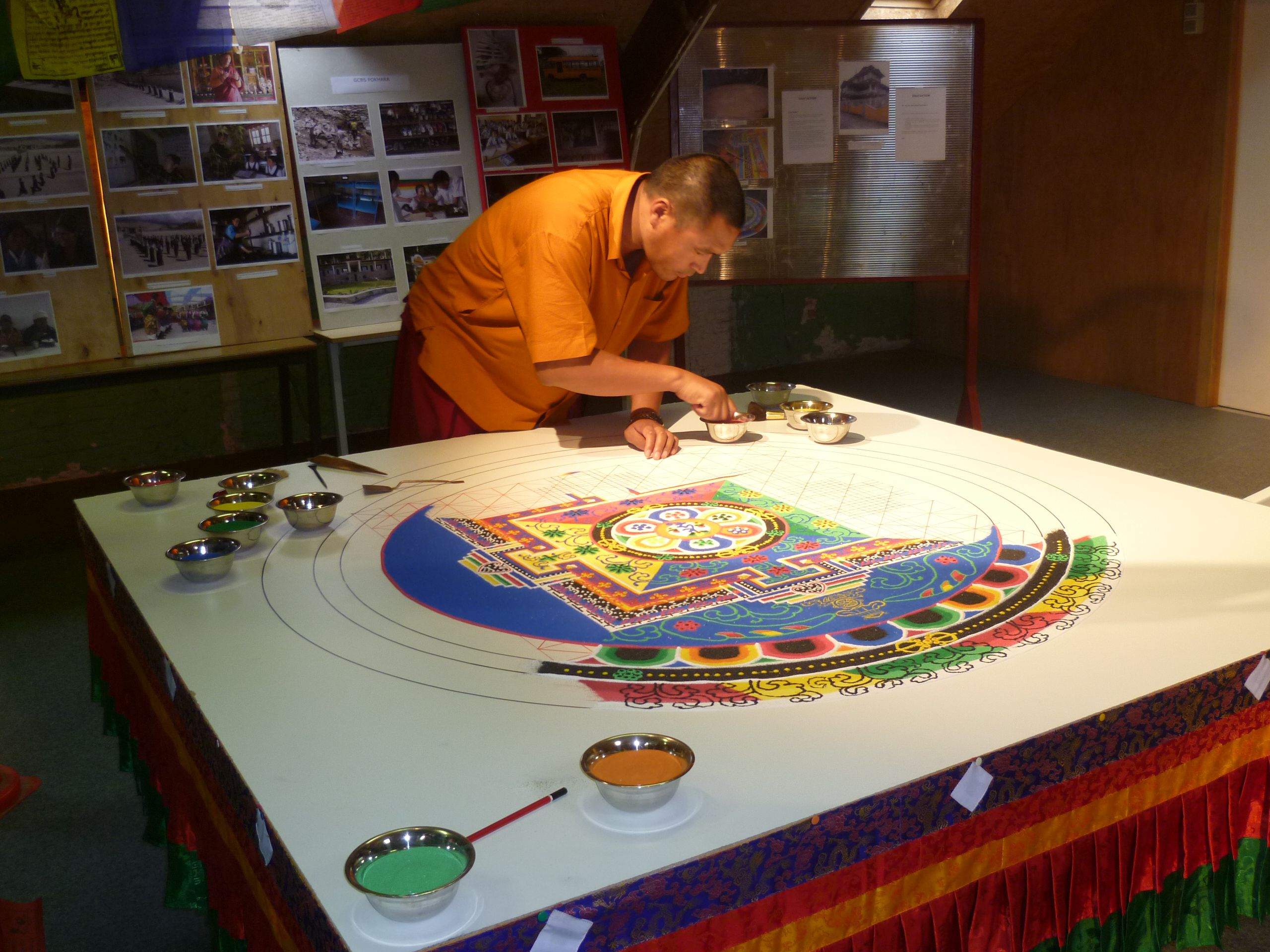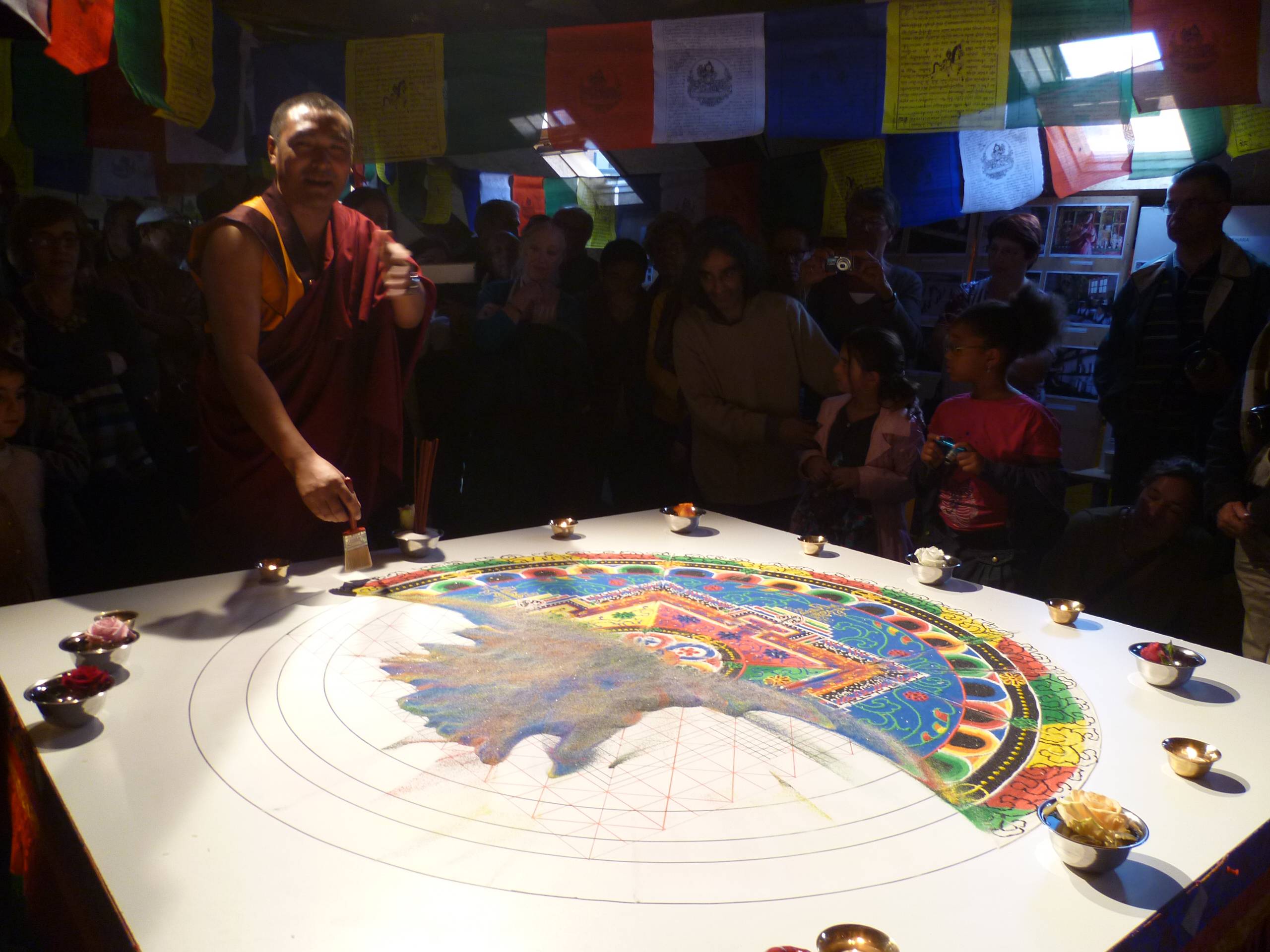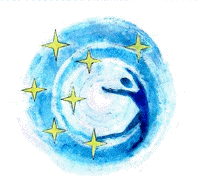LAMA NGAWANG KUNGA BISTA,
MUSTANG (NEPAL)
and
SAND MANDALAS
in benefit of his SCHOOL (GREAT COMPASSION BOARDING SCHOOL)
LAMA NGAWANG KUNGA BISTA comes from the ancient kingdom of Mustang, which has now become one of Nepal’s numerous districts. Mustang is located at the very Northern part of the country and boarders Tibet (China). The least one can tell about Lama Ngawang is that he is a monk who is socially strong committed to his region. He is the starter-founder of an ambitious education project which materializes through the “Great Compassion Boarding School” in Lo-Manthang, the capital of Mustang. He has founded his school outside the monastery in order to offer an education to girls as well. He is also the initiator of several development projects for this region, which is one of the most isolated and poorest in the world.
Lama’s history
As a very young boy, Lama was sent like many other boys of the region to the monastery of Lo-Manthang. At the age of 6, his parents decided to send him to a Tibetan monastery in India. They think this to be the most appropriate way of ensuring him a better education, in line with the Tibetan tradition. At the monastery, the young Ngawang will learn Tibetan language and will follow the whole education which is usually followed by monks. But he suffers quite a lot of being so far from his country and having no contact at all with his family. One should indeed try to realize what a shock this must have been : Mustang is located at a height which is always between 3000 and 5000 meters. it has a very dry climate, even arid and temperatures are very cold there, except during summer. In India, young Ngawang is at the level of the sea, the climate is awfully very wet with very high temperatures around 40°...
It is there that his project will be born : the young monk swears to himself that he will once go back to Mustang and that he will found a school at the monastery where he comes from, so that young boys would avoid sufferings like his.
When he reaches the age 18, young Ngawang receives the visit of his mother who he has not seen for such a long time. As a birthday present, she gives a few hundred roupies to him. With this money and with the help of a lama who had understood his projects, he “escapes” from the monastery in India and goes back to Mustang.
As he was back at the Choede monastery in his beloved Lo-Manthang, young Ngawang becomes a Lama and and asks the Kempo (head of the monastery) if he can start a school. His project is accepted and he starts it immediately. But very soon, he has to notice something which he had not foreseen : the young pupils don’t do their homeworks and sometimes even don’t work at all at home. His analyze gives him the main explanation : mothers have received no education and most of them even are illiterate. They cannot help their children... The conclusion is crystal clear : in order to succeed in educating people, it is necessary to first of all educate women. Lama Ngawang asks for the authorization to do that, but the monastery doesn’t agree. This has not been enough to undermine Lama Ngawang’s strong determination.
Like many monks, he meets many tourists in the small streets of Lo-Manthang. Most of them are trekkers who have also come to discover Mustang and its culture. Unlike most of those monks, Lama Ngawang has learned some English on his own, with his strong determination and a range of cassettes.. This allows him to communicate with them and especially to talk about his education projects. That way he becomes close friend with a German man who decides to help him. One year later, this man invites him to come for the first time to Europe in order to raise funds. That way Lama Ngawang will make his first “European” mandala in Hamburg. On this occasion, he meets Elisabeth Erne, a lady who has come from Switzerland to see the mandala. She is deeply touched by Lama’s projects and by the Mustang children and she invites the Lama to come and make a sand mandala in Switzerland as well. She soon starts a new foundation, the Himalaya’s Children Foundation. The foundation rapidly takes the responsibility to finance the construction of school buildings, first in Lo-Manthang, then in Pokhara. Today, the school welcomes about 230 children from all over Mustang and provides a Tibetan education of quality to them. Since last year, the first who have accomplished the full ten years’ cycle have come out of the school and have started higher studies. They are housed in a dedicated house, the “10+2 Hostel” which our organisation tries to help financing through the EDUC’ACTION project.
The mandala practice
Building a sand mandala is a practice which usually takes place in monasteries and which is achieved by several monks who are absorbed in this meditation process. Beyond its particular properties according the type of mandala which is being made, the goal is also to illustrate impermanence of things and non attachment. This is also why the mandala is destroyed as soon as it is finished and the sand is thrown into the nearest river in order to protect the neigbourhood. There are different types of mandalas and many of them may even not be watched at nor seen by other persons than those who were initiated to them, i.e. the monks. Other ones may be watched at by a larger public, like Avalokitechvara (Buddha of compassion), Menla (Medicine Buddha) or even Tara(purification). Seeing the building of a mandala is therefore very seldom here in Belgium and very auspicious. It is also said to benefit those who contemplate it.
OME and the mandala
Building a mandala is a way for the Lama to give something beneficial in return of the help which he receives for projects. This comes directly from the buddhist wiseness and way of thinking.
Upon OME’s invitation, and during four days, from 26th to 29th september 2012, Lama Ngawang has built for his first time in Belgium a sand mandala of about 1,8 m x 1,8 m. He had the chosen to make the Avalokitechvara mandala. He explained this by the fact that he feels that attachment causes much suffering in our Western countries. One of the possible ways to free oneself from that suffering is to develop compassion. .
In order to support his project, and more specifically the EDUC’ACTION part which is sponsored by our association, he has amazingly achieved this complex construction all alone. Many of you came and could admire this beautiful work while enjoying the atmosphere full of serenity which surrounded the place. We thank you very deep in our heart like we thank Lama Ngawang whose skill, concentration, patience and... sense of humor were appreciated by everyone. We ask you to continue to support him and to support his projects by choosing the most appropriate way for you : by becoming a member of our association, by actively taking part in EDUC’ACTION, by doing a single donation or by contacting us to sponsor one of the children of his school.
Students of Institut Notre-Dame and those from the Saturday Tibetan classes were also many to come and admire the precision and beauty of Lama Ngawang’s work and to exchange a few words with him. Some pictures of the event are available on the mandala page. They will give those who could not be present a better idea of this beautiful performance.
Saturday was the occasion for the Tibetan community to gather and to offer the public a typical celebration with songs, dances and music. At 2 PM, just before the feast began, Lama Ngawang addressed a large audience of Tibetan friends who had come to admire the mandala and their children’s performance. We very sincerely thank the “Tibetan Culture Centre” and REWA Hope asbl for their coordinating that superb celebration.
After this, a dissolution ceremony took place where the mandala was destroyed and brought to the nearest river. Many friends followed the Lama to the river where the sand full of beneficial properties was spread. We thank all the persons who were present for their visit and for their enthusiasm !
The next mandala
The success of the September 2012 edition led us together with the Lama to think about making this event an annual happening. He also insisted that it would take place on the date of H.H. the Dalai Lama’s birthday, i.e. 6th July. We have done all what we could to make it happen on that date. This year, he is going to build the Sangye Menla mandala (Medicine Buddha). We are sure everyone will welcome the beneficial virtues of this mandala as well as its healing properties.
Information and booking on this page.








Concept & Design by OME asbl. Content and all rights strictly reserved.
O.M.E. asbl
Rue de la Sapinière, 35
1170 Bruxelles
Tel./Fax : 02/452.28.23
contact@ome-asbl.org
Ouvertures et Mieux-Etre a.s.b.l.

Activités
Projets
Divers
